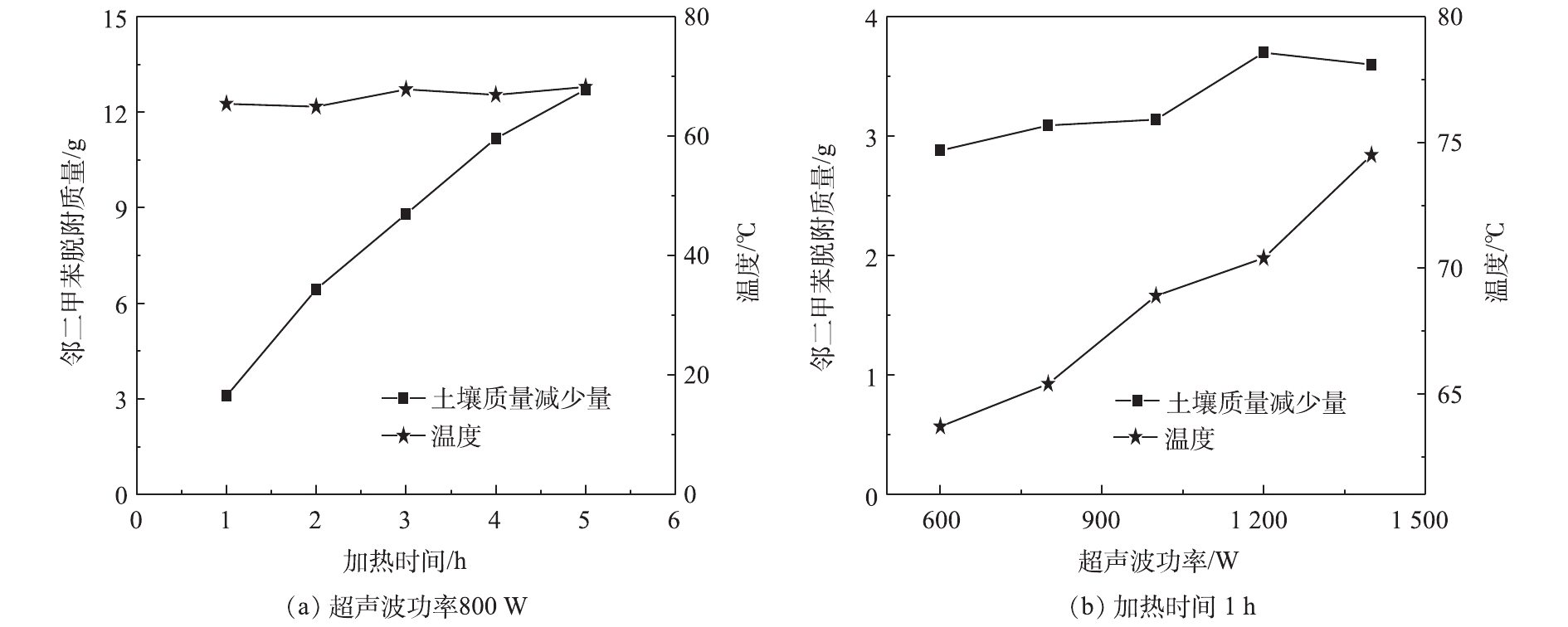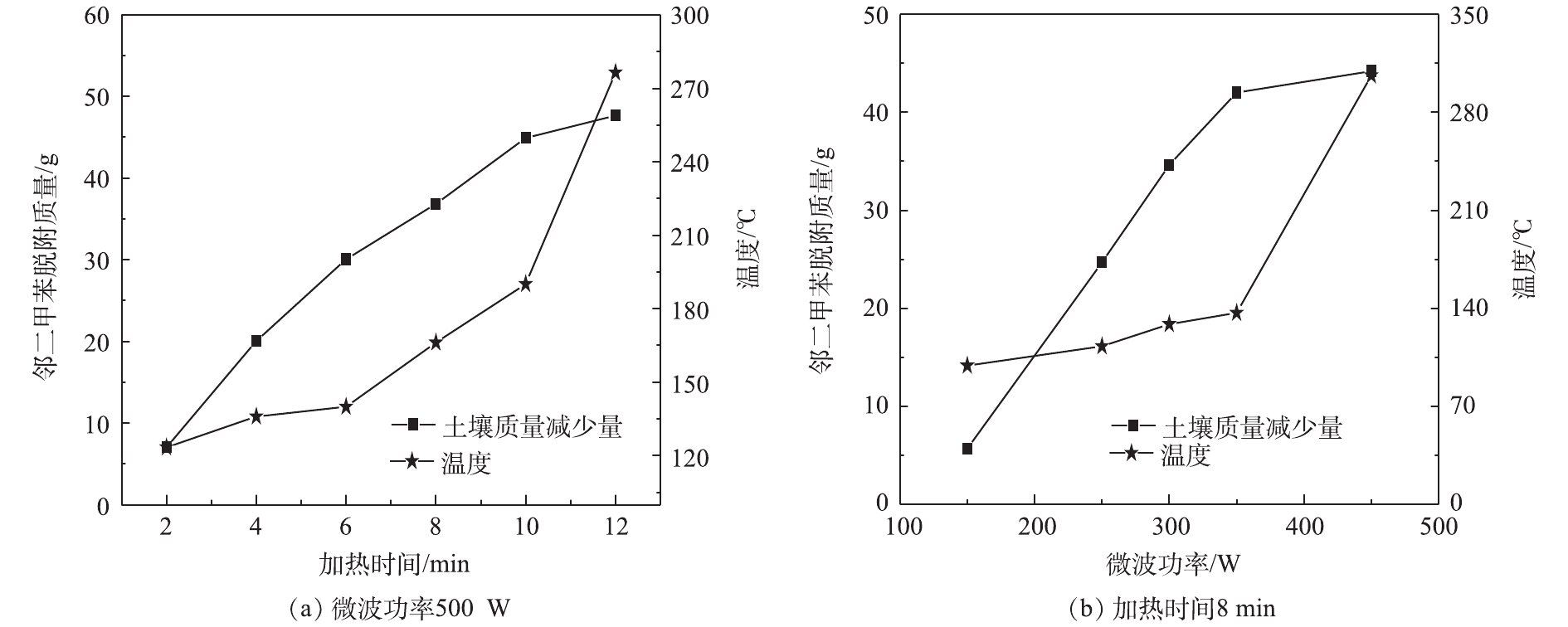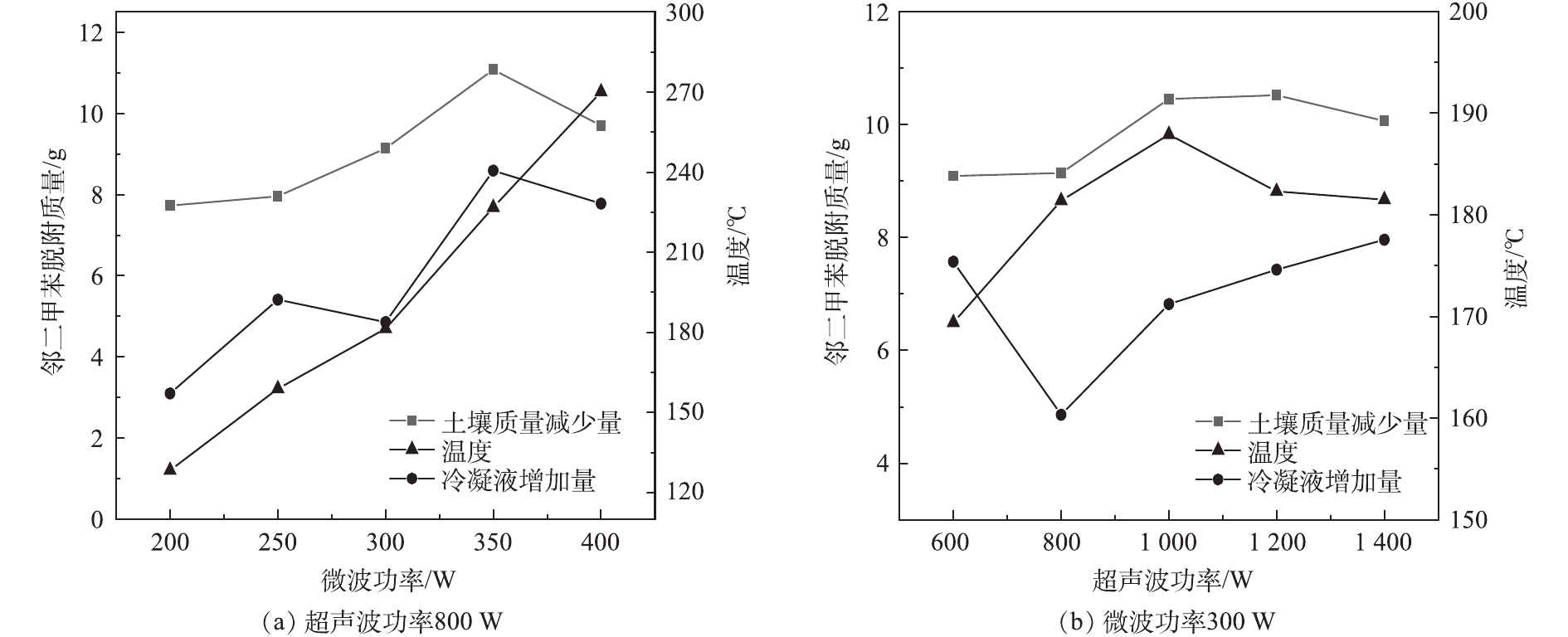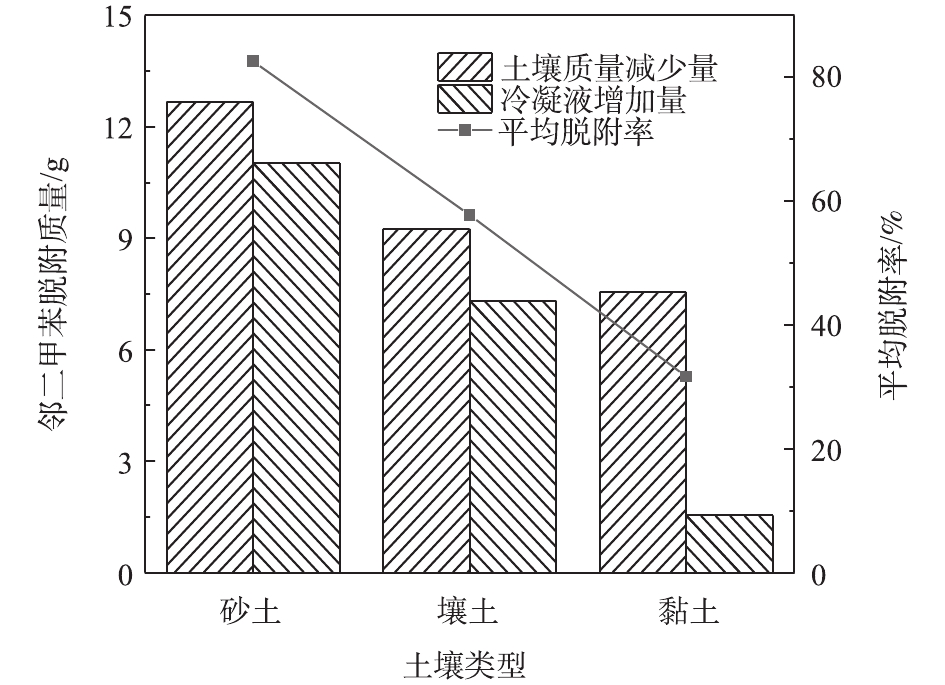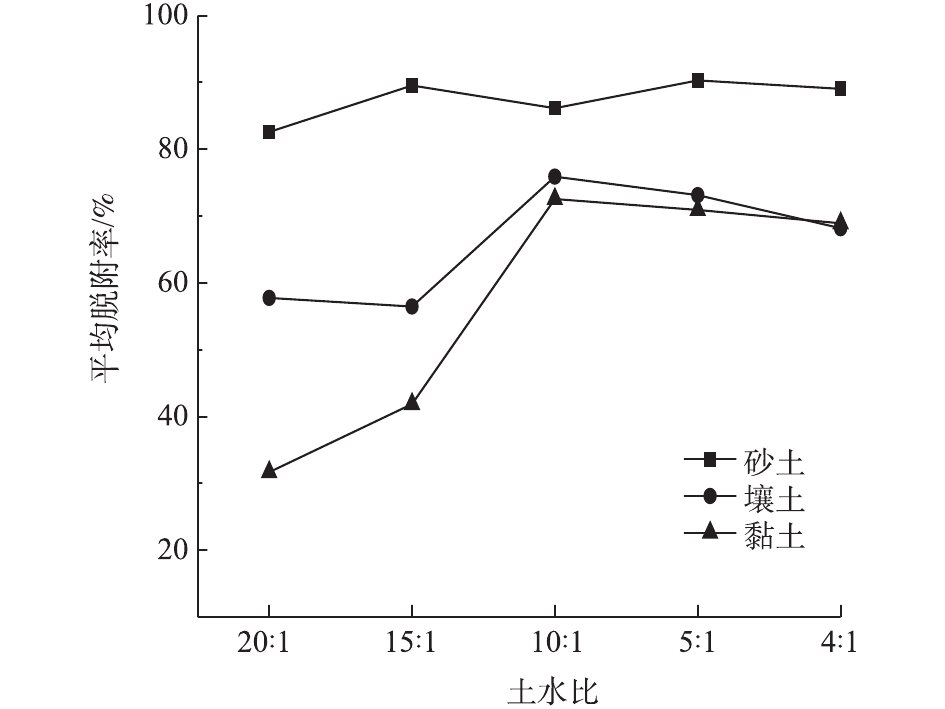-
石油是由碳氢化合物组成的复杂混合物,主要包含烃类分子、非烃类分子以及金属有机化合物[1]。其中多环芳烃(PAHs)等难降解组分一旦进入土壤中,会形成累积效应,进而破坏生态环境,威胁人类健康[2]。此外,石油烃类污染物可能通过空气、水和土壤进一步迁移,逐步形成更广阔的污染区域。目前,石油烃污染土壤的修复技术主要有生物修复、化学修复及热修复等方法。热修复技术在工程应用方面具有修复周期短、处理效果好、能够同时去除多种有机污染物等优势。因此,在石油污染土壤修复实践中,热脱附技术应用较多[3-4]。热脱附技术主要通过直接或间接加热的方式将土壤中的有机污染物加热到足够的温度,使其从污染介质上得以挥发或分离,从而达到去除土壤有机污染物的目的[5-6]。从热源类型看,除了电能(ERH、TCH等)、燃气能(GTR等)、蒸汽能(SEE等)等传统形式外,近年来,逐渐将微波和超声波等新型热源应用于污染土壤热脱附修复中。
微波加热能量以电磁波的形式穿透土壤,加热水和有机污染物使其从土壤中挥发[7]。其能量传递方式具有选择性和穿透性,加热速率不再受到表层温度、温度梯度以及热传导性等因素制约,加热时间大为缩短,其加热本质是微波在土壤中的能量耗散[8-9]。FALCIGLIA 等[10]通过改变微波加热烃类污染土壤的类型及操作条件发现,土壤质地、含水率和入射电场等参数对微波穿透性和土壤升温变化具有显著影响,然而微波无法对深层土壤形成有效辐射且深层土壤的污染物在挥发过程中会有一定比例重新吸附,故该技术具有一定的缺陷。而超声波的空化效应可以提高土壤有机污染物的解吸附速率并降低污染物与土壤颗粒之间的结合度,其提高解吸附的原理是利用超声空化现象形成微小气泡,产生高温、高压、强烈的冲击波和微射流,从而在物理上达到解吸附作用[11]。张文等[12]的研究表明,超声空化引起的解吸作用和真空抽滤是土壤总石油烃减少的主要途径,但超声波修复石油污染土壤的影响因素及其可行性研究不够充分,且单一超声波热源热效应较低。理论上,将微波与超声波技术耦合能克服各自缺点,促进土壤中污染物的脱附效果[13]。在已有研究的基础上,本研究耦合超声波与微波技术修复石油污染土壤,探索修复效果的影响因素和脱附规律,以期为石油烃类污染土壤热脱附技术提供参考。
全文HTML
-
实验采用自行设计搭建的超声波/微波耦合型热源装置处理烃类污染土壤。实验流程:将配置好的污染土壤放置于热脱附反应器中,由空气发生器与氮气发生器联合产生氮气吹扫污染土壤;热脱附后,气体由出气口排出进入冷凝系统,收集冷凝液测重;最后,尾气中残留的污染物经乙醇吸收净化后排出。实验装置如图1所示。
-
实验用土样采自未受石油污染土壤,先经自然风干,过10目标准筛(筛孔尺寸2 mm),然后测其粒径级配,结果如表1所示。
-
以石油烃污染土壤为研究对象,烃类化合物是构成石油的主要成分(约占95%~99%),包括烷烃、环烷烃、芳香烃等。一般来说,芳香烃较烷烃和环烷烃更难脱附,本研究使用邻二甲苯作为石油烃的典型代表进行分析。
分别以微波、超声波作为单一热源进行热脱附实验。取200 g干燥壤土,配置成土水比为4∶1、邻二甲苯质量浓度为5.0%的模拟污染土壤,放入热脱附装置中进行实验。在双热源条件下,耦合超声与微波为热源进行实验,取200 g干燥壤土,配置成土水比为20∶1、邻二甲苯浓度为2.0%的模拟污染土壤,放入热脱附装置中进行实验。
土质条件(土壤质地、土水比、污染浓度)实验采取双热源加热方式(微波功率为300 W,超声波功率为800 W),加热时间为30 min,实验模式为温度恒定模式。实验分别取200 g干燥土壤(砂土、壤土、黏土),配置成土水比为20∶1、邻二甲苯浓度为2.0%的模拟污染土壤,放入热脱附装置中进行不同土壤类型实验。分别取200 g干燥土壤(砂土、壤土、黏土),配置成邻二甲苯浓度为2%、土水比分别为20∶1、15∶1、10∶1、5∶1、4∶1的模拟土壤进行土水比实验。分别取200 g干燥土壤(砂土、壤土、黏土),配置成土水比为20∶1,邻二甲苯浓度分别为2%、4%、6%、8%、10%的模拟污染土壤进行污染物浓度实验。
鉴于污染物进入土壤后会发生一系列的扩散吸附行为,特别是经过一段时间的老化后,相当部分的污染物会发生解吸滞后行为。为了更好地模拟污染土壤,本研究中制备的污染土壤,均放置7 d后,再进行上述实验,以便污染物与土壤充分接触、结合。
-
采用土壤质量减少量及冷凝液质量增加量2种手段对污染土壤的热脱附效果进行综合评价。土壤质量减少量、冷凝液质量增加量、邻二甲苯及水分的平均脱附质量、平均脱附效率按式(1)~式(4)计算。
式中:m为土壤质量减少量(含水和邻二甲苯),g;m1为实验前土壤质量,g;m2为实验后土壤质量,g;n为冷凝液质量增加量,g;n1为实验前冷凝瓶质量,g;n2为实验结束后冷凝瓶质量,g;x为邻二甲苯和水分的平均脱附质量,g;y为土样中邻二甲苯和水分总质量,g;z为平均脱附效率。
1.1. 实验装置和土壤样品粒径级配
1.2. 实验方法
1.3. 热脱附效果与评价手段
-
超声波单热源实验条件分为2种情况:加热时间为1、2、3、4和5 h(超声功率固定为800 W);功率为600、800、1 000、1 200和1 400 W(加热时间固定为1 h)。研究了超声波单热源对升温和邻二甲苯脱附效果的影响,结果如图2所示。在超声波功率恒定的情况下,温度随加热时间变化幅度较小,基本维持在65~70 ℃,5 h后,装置内温度升高至68.2 ℃。此外,热脱附是一个持续的过程,随着加热时间的延长,污染物的去除量有显著增加,5 h后,脱附物质的质量可达到12.71 g,相应的脱附率约为21.76%。在超声波加热时间恒定的情况下,其温度随功率的增大而逐渐升高,且升幅明显,超声功率在1 200 W时装置内温度升至74.5 ℃;随着超声波加热功率的增大,污染物的去除量也相应增大,但增加幅度稍弱于加热时间条件下的变化幅度;当超声功率为1 200 W时,热脱附效果最佳,脱附的污染物质量可达到3.7 g,脱附率为6.16%。
加热时间与土壤温度是影响超声波加热对污染物去除的重要因素。在超声波功率固定的情况下,随着加热时间的延长,土壤温度维持稳定,但污染物的去除率呈线性升高。这可能是由于温度较高,且长时间持续通入氮气,加速了邻二甲苯在土壤中的挥发,从而导致污染物的去除率不断提高。而在固定超声波加热时间,不断提高超声波功率的情况下,污染物的去除效果并不明显,在超声波功率为1 400 W,加热1 h后,装置中土壤最高温度可达到74.5 ℃,但污染物去除率仅为5.99%,因此,在超声波加热过程中,功率并不是主要的影响因素。SHI等[11]的研究表明,过大的超声波功率会使空化气泡在超声波的负相形成声屏障,降低可利用的声场能量,进而影响污染物的去除效果。此外,土壤样品量与反应容器的尺寸也可能影响污染物的去除效果。考虑到经济节能,在后续实验中,超声波功率设定为800 W。
-
微波单热源条件分别设为2种情况:加热时间为2、4、6、8、10和12 min(微波功率固定为500 W);加热功率为150、250、300、350和450 W(加热时间固定为8 min)。实验研究了微波单热源条件对反应器升温和污染物脱附效果的影响,结果如图3所示。
由图3(a)可知,在微波功率恒定的情况下,随着微波加热时间的延长,污染物的去除效果持续增强。12 min时,土壤温度升高至276.4 ℃(装置最高耐受温度为300 ℃),此时邻二甲苯脱附质量为47.66 g,相应的脱附率为75.59%。土壤温度在前6 min时增长较慢,这是由于该阶段土壤处于预热阶段,邻二甲苯与水同时受热,水分先于邻二甲苯挥发(邻二甲苯沸点137~140 ℃),污染物去除率显著提高。吕顺亮等[13]研究微波加热柴油污染土壤时发现,随着微波辐照时间的延长,土壤含水率逐渐降低,挥发作用减弱,热分解作用增强,污染物可能会分解成易挥发的小分子或被碳化。当加热时间为10 min时,土壤温度升高至191 ℃,远超邻二甲苯沸点,污染物去除速率逐渐趋于平缓,且装置内水分已基本挥发,土壤的有效介电损耗因子降低,吸波能力减弱,因此,选取微波加热时间10 min为宜。
由图3(b)可知,在加热时间恒定的情况下,随着微波功率的增加,加热土壤的升温速率和所达到的最高温度增大。当功率为450 W时,达到最高温度306.4 ℃,邻二甲苯脱附质量最高可达44.2 g,相应的污染物脱附率为70.10%。当微波功率低于350 W时,装置升温速率较低,土壤处于预热阶段,升温速率较慢。在350~400 W时,污染物脱附率变化并不明显。非单一组成物质在微波场中的吸波升温行为[14]可由式(5)表示。
式中:T为微波加热后的物质温度,℃;T0为物质的初始温度,℃;t为微波辐照时间,min;f为微波频率,Hz;ε0为真空介电常数,F·m−1;ε'为物质的有效介电损耗因子;E为电场强度,V·m−1;ρ为物质的密度,kg ·m−3; C为物质的比热容,J·(kg·℃)−1。
由式(5)可知,物体在微波中的加热速率与介电损耗因子正相关,与物体热容负相关。随着微波功率的增大,微波的电场强度随之增大,升温速度逐渐加快[15]。通过对比微波与超声的加热速率与污染物的去除效果,微波为热源的热脱附处理效果大于超声为热源的热脱附处理效果。
-
超声波与微波耦合热源条件分别设为2种情况:微波功率为200、250、300、350和400 W(超声波功率固定为800 W),加热10 min,升温规律及热脱附结果见图4(a);超声波功率为600、800、1 000、1 200和1 400 W(微波功率固定为350 W),加热10 min,升温规律及热脱附结果见图4(b)。
图4(a)显示,在超声波功率恒定的情况下,增大微波功率 (从200 W增加至400 W)能显著提升装置内反应温度(从128.3 ℃升高至270.1 ℃),显示了微波较强的热效应;而图4(b)显示,在微波功率恒定的情况下,增大超声波功率(从600 W增到1 400 W)对装置升温效果影响不明显(从169.4增加到187.9 ℃),这也再次说明了超声波较弱的热效应。由图4(a)可知,在超声波功率恒定的情况下,污染物脱除量总体上随微波功率的增加而明显增大。微波功率达到350 W时,土壤质量减少量为11.08 g,冷凝液质量增加量为8.59 g,相应的平均脱附效率达到峰值,为77.28%,明显高于单独微波加热同等条件(功率350 W)下的污染物脱附效率66.63%(见图3)。这是因为,在微波-超声波耦合情况下,超声波可以提高土壤颗粒表面的剪切力和污染物的扩散速率,可以增强吸附于土壤颗粒上污染物的解吸效率,超声波作为辅助热源对于微波加热过程具有较好的促进作用[11]。当继续增大微波功率后,热脱附效率反而降低,可能是因为在功率增大的情况下,土壤温度升高的速率加快,产生的热解气快速离开土壤,热能的利用率较低,从而减弱了邻二甲苯的去除效果。
考虑到单独微波功率超过350 W后,加热效果可满足污染物去除的要求,因此,选定微波功率为350 W,旨在研究超声-微波耦合热源的热脱附效果。由图4(b)可知,在微波功率恒定的情况下,随超声波功率的增加,污染物脱附量总体上呈现略微上升的趋势。当超声波功率为1 400 W时,土壤质量减少量为10.06 g,冷凝液质量增加量为7.96 g,相应的平均脱附效率可达到70.1%。AMANI等[16]的研究表明,超声波的机械振动作用可使弹性粒子的振幅、速度及加速度显著提高,油样中的小分子与惰性大分子链间发生显著的相对运动,增强分子间的摩擦力,从而打断C—C键,破碎大分子基团,进而加速污染物去除。但在超声波功率为800 W时,污染物的去除效果远低于同等条件下其他功率下的去除效果。由黄欣桐等[17]的研究可以得知,超声波的空化效应可以瞬间产生高温、高压、高速微射流,改变烃类物质的内部结构。因此,该阶段脱附率的降低可能是由于超声的空化效应与微波的共同作用,导致邻二甲苯裂解为小分子物质吸附到土壤颗粒表面,加大热脱附难度,导致污染物的去除率降低。而超声波功率在1 000~1 400 W时,温度降低,热脱附效果减弱。这可能是由于在微波与超声波的共同作用下,邻二甲苯与水形成水合物,沸点降低,加热前期大量蒸发,介电损耗因子减少,从而导致微波/超声波加热效果减弱。对比微波与超声波作为辅助热源的实验结果,微波在能耗更低的情况下对污染物具有更好的热脱附效果,即微波作为主热源的脱附效果优于超声波。
-
如图5 所示,在同等实验条件下,超声波-微波耦合型热源针对不同土壤类型中污染物的热脱附效果有较大差别,对应的平均脱附效率排序为砂土(88.36%)>壤土(64.29%)>黏土 (52.61%)。这可能是由于不同种类土壤的粒径有所不同,其中粒径为50~2 000 μm 的砂土占比达到 80%以上,颗粒较大,透水性良好,有利于污染物充分混合,同时邻二甲苯的疏水性使其较易被去除;而粒径小于 2 μm 的黏土占比为 45.87%,较大的比表面积增加了黏土颗粒对污染物的固定作用,从而加大了污染物的脱附难度。MASON 等[18]研究发现,超声作用产生的泡沫崩溃时引起的高速微喷射流与冲击波、经碰撞所致的颗粒破碎、超声波的毛细管作用等因素的共同作用,有助于提高污染物的净化效率。此外,不同土壤中的有机质含量不同,会直接影响微波/超声波对污染土壤修的复效果,一般有机质含量丰富的土壤能更好地吸收微波能量,从而加速了污染物的去除。
-
如图6所示,不同土水比对于污染物的热脱附效果具有一定的影响,其中对于砂土的影响较弱,对黏土的影响较为明显,对壤土的影响介于沙土、黏土之间。
土壤中的水分是主要的微波吸收质,直接反映在对土壤介电损耗因子的影响上。而水含量与土壤介电性质之间并非线性关系,二者的结合方式对介电性质影响较大,自由水微波吸收能力远大于结合水[7]。由图6可知,在同等实验条件下,砂土中污染物的热脱附效率基本维持在80%~95%,这可能与砂土的粒径较大和有机质含量较低等因素有关。而黏土与壤土在土水比10∶1时脱附效果最好,升高或降低含水率均会影响热脱附效率,这可能是由于含水率的增加,水的蒸发作用变强,介电损耗因子增加,促进了邻二甲苯的去除效果。而土壤含水率超过10%后可能会影响超声波的空化效应及机械振动,增加土壤比热容,从而限制微波-超声波的加热效果。除此以外,土壤含水率过高可能会减小土壤中气体流动通道并降低土壤的通透性,导致产生的高温热解气不能快速排出,阻碍了污染物的热脱附效果,从而导致脱附效率降低。孙磊等[19]发现,在含水率较低时,污染物在土壤中的残留量随含水率的增加而降低,当含水率达到一定程度后,其残留量又随土壤含水率的增加而增加。本研究结果与孙磊等[19]的研究结果相似,故具有一定的客观性及参考价值。
-
不同土壤中污染物浓度的热脱附效果如图7所示。总体上,土壤污染程度对平均脱附率的影响较为温和。在同等条件下,砂土的热脱附效果最佳,当污染物浓度为8%时,平均脱附率最高,为94.42%。而黏土与壤土中污染物浓度在4%时,脱附效果(黏土70.83%、壤土76.81%)最好。在污染物浓度过低时,强大的结合力使邻二甲苯分子在土壤颗粒表面上呈单层吸附,若解吸能不足以破坏污染物与土壤颗粒间的结合力,可导致热脱附效果不佳[20]。当污染浓度继续增加时,热脱附效果呈降低趋势。这可能是由于微波-超声波耦合加热过程中,邻二甲苯分子在土壤颗粒表面呈多层吸附,土壤颗粒对中层、内层的邻二甲苯分子的吸附作用力较强,更难被超声空化解析出来。
2.1. 超声波单热源条件对升温及脱附效果的影响
2.2. 微波单热源条件对升温及脱附效果的影响
2.3. 超声波-微波耦合双热源对升温及脱附效果的影响
2.4. 土壤类型对超声波-微波耦合热脱附效果的影响
2.5. 土壤土水比对超声波-微波耦合热脱附效果的影响
2.6. 土壤污染物浓度对超声波-微波耦合热脱附效果的影响
-
1) 研究结果显示了微波较强的热效应及超声波较弱的热效应,微波耦合超声波的协同作用优于单独微波的脱附效果,但差别不大。今后应该强化超声波的非热协同效应方面的研究工作,实现低能高效的修复目标。
2) 不同质地土壤的平均脱附率排序为砂土(88.36%)>壤土(64.29%)>黏土(52.61%),排序主要取决于其不同的土壤粒径及有机质含量,这符合预期的效果。土水比对砂土影响不明显,对壤土和黏土来说,最佳土水比为10∶1。因此,在修复实践中,除应考虑土壤含水率对能耗的影响外,还应考虑其对脱附效率的影响。
3) 超声波-微波耦合热源修复壤土的最优工艺参数为土水比20∶1、超声波功率800 W、微波功率350 W、辐照10 min,相应的污染物平均脱附率最高可达77.28%。上述结果表明了超声波-微波耦合修复石油烃污染土壤的可行性。



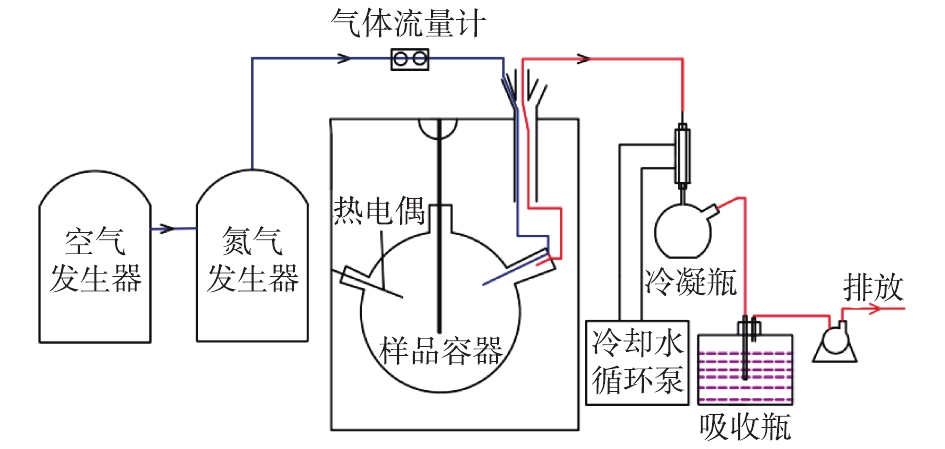
 下载:
下载:
